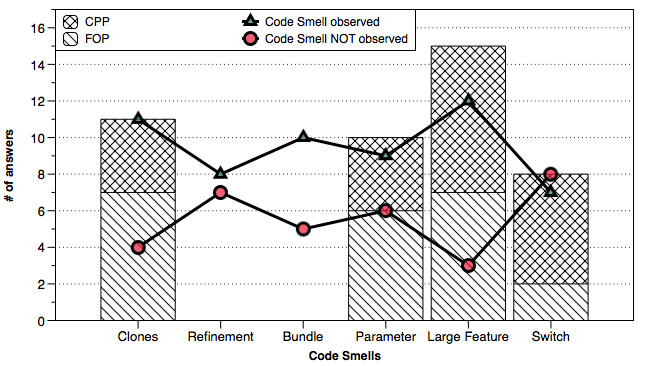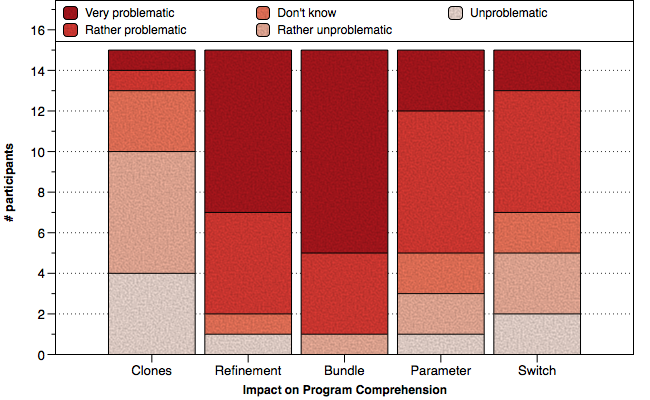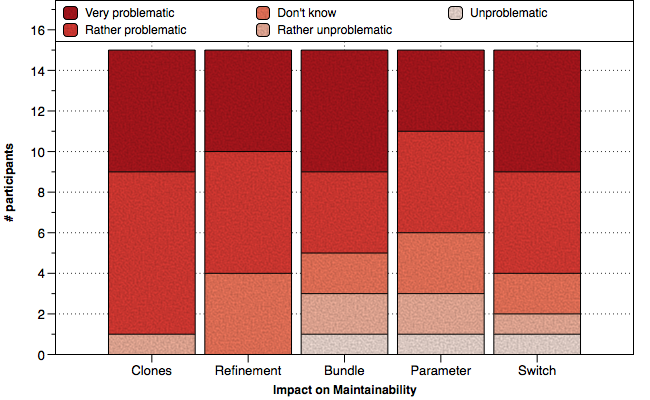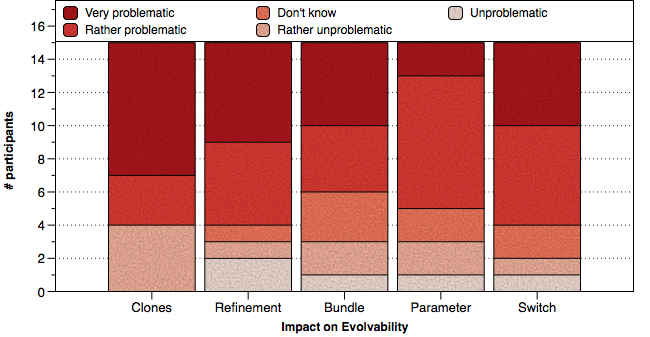Variability-Aware Code Smells for Annotation-Based an Composition-Based Variability Mechanisms
-- Supplementary Material for VAMOS 2015 --


Overview
Highly-configurable software systems (also known as software product lines) gain momentum in both, academia and industry. For instance, the Linux kernel comes with over 12,000 configuration options and thus, can be customized to run on a variety of system with different properties such as architecture or processor. To a large degree, this configurability is achieved through variable code structures, for instance, using conditional compilation with the C preprocessor. Such source code variability adds a new dimension of complexity and thus, giving rise to new possibilities for design flaws. Code smells are an established concept to describe design flaws or decay in source code. However, existing smells have no notion of variability and thus fail to suitably characterize flaws of variable code structures.
We address this lack of varibaility support by proposing an initial catalog of six variability-aware code smells. In our paper, we discuss the appearance and negative effects of these smells and present code examples from real-world systems. To evaluate our catalog, we have conducted a survey amongst 15 researchers from the field of software product lines. As a key result of this survey, we can confirm that our proposed smells a) have been observed in existing product lines and b) are considered to be problematic for important software development activities, such as program comprehension, maintenance, and evolution. On this page, we provide supplementary material for this survey.
Survey -- Questionnaire and additional information
To evaluate our proposed, variability-aware code smells, we conducted a survey with researchers in the field of software product lines (SPL), which is our target domain. Our goal was to have a first evaluation of our smells, based on experiences with SPL programming. Particularly, we had two questions in mind we want to answer, based on this survey: First, whether participants of the survey oberserved one or more of these smells in the described (or similar) form. Second, how participants, based on their experience, would estimate the (assumably negative) effects of these smells on program comprehension, maintainability, and evolvability.
To this end, we provided the following material for participants of the survey:
- Description of variability-aware code smells (Download PDF):
This description contains a description for reach of the six smells, similarly to the catalogue in the paper, but with a less comprehensive reasoning about the impact of a smell. Moreover, we included a code example for each of the smells, which was not possible in the paper (due to space restrictions).
- Questionnaire (Download as PDF):
We divided the questionnaire in five different sections: personal data, background&experiences, code smells (in general), and questions about variability-aware code smells.
We made the questionnaire available online, using the lime survey, an open-source survey application.
Results of the survey
Overall, 17 researcher participated in our survey. Since two of them provided an incomplete questionnaire, we excluded them form our results. Next, we show the results of our survey in two forms: First, the pure statistics (in HTML format) as provided by Lime survey. Second, aggregated results in form of charts.
Detailed results:
- Personal Data (view HTML)
- Background & Experiences:
- Programming Experience in general (view HTML):
Questions about years programming experience, programming paradigms participants are familiar with and software projects participants worked on
- Product-Line Experience (view HTML):
More specific than above, we asked for experience with SPLs in general, with developing SPLs, variability mechanisms applied for development and other activities with SPLs such as analysis or testing.
- Code Smells (view HTML):
Questions about knowledge about the original conepts of code smells as, for instance, introduced by Fowler.
Variability-Aware Code Smells:This part encompasses questions regarding our proposed code smells. Particularly, we asked whether participants observed these smells, in which kind of software project (e.g., open source, industrial) and whether they expect these smells to be problematic regarding program comprehension, maintianability, and evolvability.
Aggregated results:
Observed Code Smells:
 Above, we show how many participants observed our proposed code smells. Moreover, we show to what extent these smells have been observed in systems with composition-based (here: FOP) and annotation-based (here: C preprocessor CPP) systems, respectively.
Above, we show how many participants observed our proposed code smells. Moreover, we show to what extent these smells have been observed in systems with composition-based (here: FOP) and annotation-based (here: C preprocessor CPP) systems, respectively.
Impact of Code Smells:
 How do participants estimate the impact of our code smells on program comprehension? The bar chart above aggregates their answers and indicates that the majority assumes that the smells are rather problematic, especially Long Refinement Chain and Annotation Bundle.
How do participants estimate the impact of our code smells on program comprehension? The bar chart above aggregates their answers and indicates that the majority assumes that the smells are rather problematic, especially Long Refinement Chain and Annotation Bundle.
 Results for the estimated impact of our smells on maintainability.
Results for the estimated impact of our smells on maintainability.
 Results for the estimated impact of our smells on evolvability.
Results for the estimated impact of our smells on evolvability.
 Above, we show how many participants observed our proposed code smells. Moreover, we show to what extent these smells have been observed in systems with composition-based (here: FOP) and annotation-based (here: C preprocessor CPP) systems, respectively.
Above, we show how many participants observed our proposed code smells. Moreover, we show to what extent these smells have been observed in systems with composition-based (here: FOP) and annotation-based (here: C preprocessor CPP) systems, respectively.